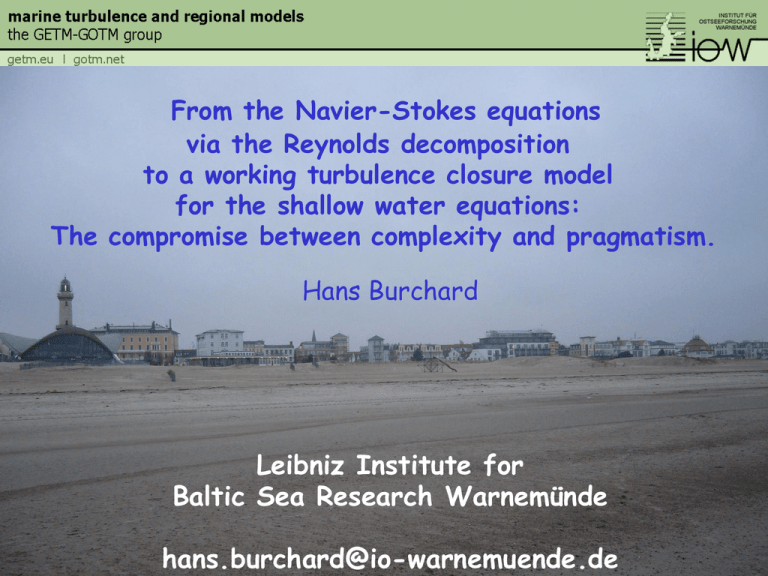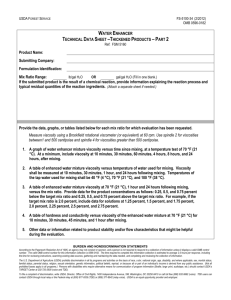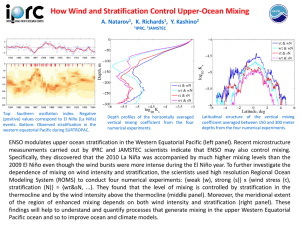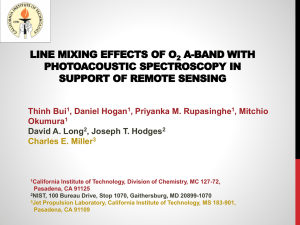Navier-Stokes equations
advertisement

From the Navier-Stokes equations via the Reynolds decomposition to a working turbulence closure model for the shallow water equations: The compromise between complexity and pragmatism. Hans Burchard Leibniz Institute for Baltic Sea Research Warnemünde hans.burchard@io-warnemuende.de Why are we stirring our cup of coffee? Milk foam: light, because of foam and fat Coffee: relatively light, because hot Milk: less light, because colder than coffee Why the spoon? …OK, and why the coocky? little mixing strong mixing little stirring strong stirring From stirring to mixing … Tea mixing (analytical solution) Put 50% of milk into tea. z Let m(z) be the milk fraction with m=1 at the bottom and m=0 at the surface. With a constant mixing coefficient, the m-equation is this: 10cm Let us take the spoon and stir the milk-tea mix n-times such that we get a sinosodial milk-tea variation in the vertical and then see the resulting mixing after 1 min: Conclusion: stirring leads to increased mixing. Set of equations that describes turbulent mixing Navier-Stokes equations (for velocity vector u1, u2, u3): tendency advection Incompressibility stress divergence condition: Earth rotation pressure gradient gravitational force 6 equations for 6 unknowns (u1, u2, u3, p, , ) Temperature equation: stirring Equation of state: mixing Example for solution of Navier-Stokes equations (KH-instability) Direct Numerical Simulation (DNS) by William D. Smyth, Oregon State University Reynolds decomposition To reproduce system-wide mixing, the smallest dissipative scales must be resolved by numerical models (DNS). This does not work in models for natural waters due to limited capacities of computers. Therefore, the effects of turbulence needs to be partially (= Large Eddy Simulation, LES) or fully (Reynolds-averaged Navier-Stokes, RANS) parametersised. Here, we go for the RANS method, which means that small-scale fluctuations are „averaged away“, i.e., it is only the expected value of the state variables considered and not the actual value. Reynolds decomposition (with synthetic tidal flow data) Any turbulent flow can be decomposed into mean and fluctuating components: Reynolds decomposition There are many ways to define the mean flow, e.g. time averaging (upper panel) or ensemble averaging (lower panel). For the ensemble averaging, a high number N of macroscopically identical experiments is carried out and then the mean of those results is taken. The limit for N is then the ensemble average (which is the physically correct one). Time averaging Ensemble averaging Reynolds decomposition For the ensemble average 4 basic rules apply: Linearity Differentiation Double averaging Product averaging The Reynolds equations These rules can be applied to derive a balance equation for the ensemble averaged momentum. This is demonstrated here for a simplified (one-dimensional) momentum equation: The Reynolds stress constitutes a new unknown which needs to be parameterised. The eddy viscosity assumption Reynolds stress and mean shear are assumed to be proportional to each others: eddy viscosity The eddy viscosity assumption The eddy viscosity is typically orders of magnitude larger than the molecular viscosity. The eddy viscosity is however unknown as well and highly variable in time and space. Parameterisation of the eddy viscosity Like in the theory of ideal gases, the eddy viscosity can be assumed to be proportional to a characteristic length scale l and a velocity scale v: In simple cases, the length scale l could be taken from geometric arguments (such as being proportional to the distance from the wall). The velocity scale v can be taken as proportional to the square root of the turbulent kinetic energy (TKE) which is defined as: such that (cl = const) Dynamic equation for the TKE A dynamic equation for the turbulent kinetic energy (TKE) can be derived: with P: shear production B: buoyancy production e: viscous dissipation Dynamic equation for the length scale (here: e eq.) A dynamic equation for the dissipation rate of the TKE) is constructed: with the adjustable empirical parameters c1, c2, c3, se. With this, it can be calculated with simple stability functions cm and cm‘. All parameters can be calibrated to characteristic properties of the flow. Example on next slide: how to calibrate c3. Layers with homogeneous stratification and shear For stationary & homogeneous stratified shear flow, Osborn (1980) proposed the following relation: which is equivalent to (N is the buoyancy frequency), a relation which is intensively used to derive the eddy diffusivity from micro-structure observations. For stationary homogeneous shear layers, the k-e model reduces to which can be combined to . Thus, after having calibrated c1 and c2, c3 adjusts the effect of stratification on mixing. Umlauf (2009), Burchard and Hetland (2010) Mixing = micro-structure variance decay Example: temperature mixing Temperature equation: Temperature variance equation: Mixing Second-moment closures in a nut shell Instead of directly imposing the eddy viscosity assumption With one could also derive a transport equation for and the turbulent heat flux (second moments). These second-moment equations would contain unknown third moments, for which also equations could be derived, etc. The second-moments are closed by assuming local equilibrium (stationarity, homogeneity) for the second moments. Together with further emipirical closure assumptions, a closed linear system of equations will then be found for the second moments. Interestingly, the result may be , where now cm and cm‘ are formulations as follows: functions of and with the shear squared, M2. Such two-equation second moment-closures are now the workhorses in coastal ocean modelling (and should be it in lake models) and have been consistently implemented in the one-dimensional General Ocean Turbulence Model (GOTM) which has been released in 1999 by Hans Burchard and Karsten Bolding under the Gnu Public Licence. Since then, it had been steadily developed and is now coupled to many ocean models. GOTM application: Kato-Phillips experiment Stress-induced entrainment into linearly stratified fluid Dm(t) Empirical G<0.2 G>0.2 Empirical: GOTM application: Baltic Sea surface dynamics unstable Reissmann et al., 2009 Take home: Due to stirring, turbulence leads to an increase of effective mixing and dissipation by several orders of magnitude. For simulating natural systems, the Reynolds decomposition into mean (=expected) and fluctuating parts is necessary. Higher statistical moments are parameterised by means of turbulence closure models. Algebraic second-moment closures provide a good compromise between efficiency and accuracy. Therefore such models are ideal for lakes and coastal waters. Question: Will we be able to construct a robost and more accurate closure model which resolves the second moments ( inclusion of budget equations for momentum and heat flux)?










